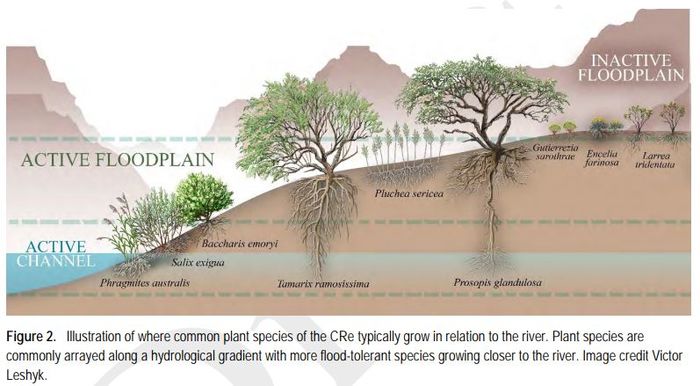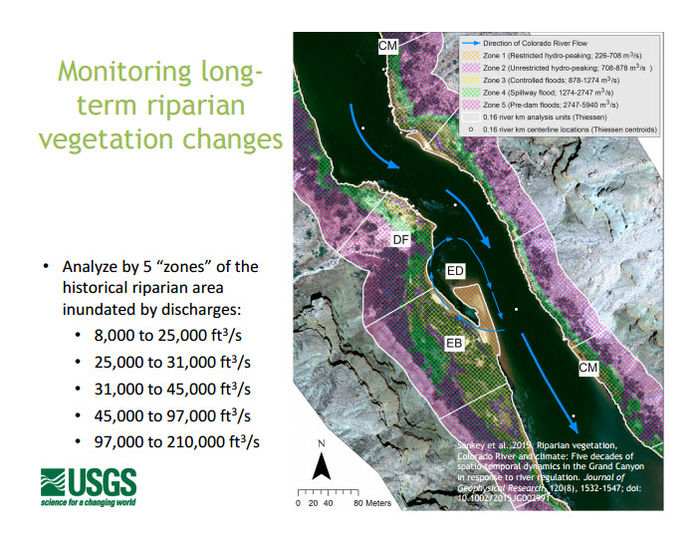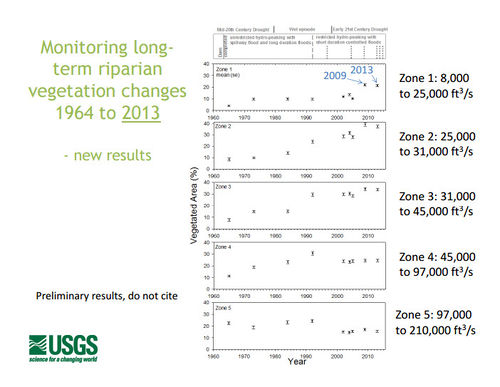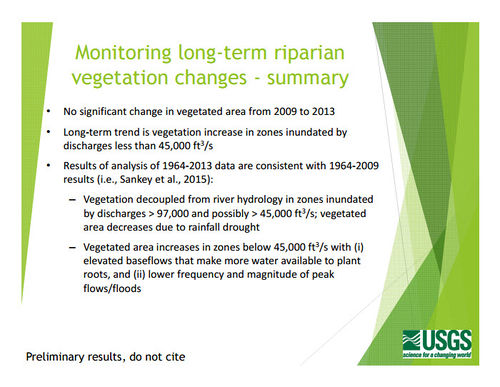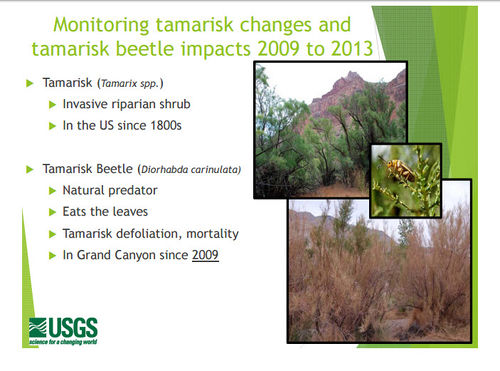Difference between revisions of "Riparian Vegetation"
Cellsworth (Talk | contribs) |
Cellsworth (Talk | contribs) |
||
| (41 intermediate revisions by the same user not shown) | |||
| Line 17: | Line 17: | ||
</table> | </table> | ||
| − | [[Image:VegetationMonitoring.jpg| | + | [[Image:RiparianVegetation.JPG|700px|center]] |
| + | [[Image:VegetationMonitoring.jpg|700px|center]] | ||
<!-- | <!-- | ||
| Line 62: | Line 63: | ||
|style="color:#000;"| | |style="color:#000;"| | ||
| − | [[ | + | [[Image:VegMonitoring_1964_2013.jpg|thumb|500px|center| [http://www.usbr.gov/uc/rm/amp/amwg/mtgs/16aug24/Attach_07c.pdf http://www.usbr.gov/uc/rm/amp/amwg/mtgs/16aug24/Attach_07c.pdf] ]] |
| − | [[Image: | + | [[Image:VegMonitoring_summary.jpg|thumb|500px|center| [http://www.usbr.gov/uc/rm/amp/amwg/mtgs/16aug24/Attach_07c.pdf http://www.usbr.gov/uc/rm/amp/amwg/mtgs/16aug24/Attach_07c.pdf] ]] |
| − | [[Image: | + | [[Image:TamariskBeetle.jpg|500px|thumb|500px|center| [http://www.usbr.gov/uc/rm/amp/amwg/mtgs/16aug24/Attach_07c.pdf http://www.usbr.gov/uc/rm/amp/amwg/mtgs/16aug24/Attach_07c.pdf] ]] |
| − | + | ||
| − | + | ||
|} | |} | ||
| Line 81: | Line 80: | ||
|style="color:#000;"| | |style="color:#000;"| | ||
| + | *[http://gcdamp.com/index.php?title=Portal:GCDAMP_Knowlege_Assessments GCMRC Annual Reports page] | ||
*[https://parkplanning.nps.gov/document.cfm?parkID=65&projectID=18978&documentID=26011 Environmental Assessment for Exotic Plant Management Plan in Grand Canyon] | *[https://parkplanning.nps.gov/document.cfm?parkID=65&projectID=18978&documentID=26011 Environmental Assessment for Exotic Plant Management Plan in Grand Canyon] | ||
| + | *[http://gcdamp.com/index.php?title=RECREATION Recreation Page] | ||
| + | *[http://gcdamp.com/index.php?title=Aeolian_Sand_Transport Aeolian Sand Transport Page] | ||
| + | *[http://gcdamp.com/index.php?title=GCDAMP-_Over-Flights Over Flights Page] | ||
|- | |- | ||
| Line 95: | Line 98: | ||
|- | |- | ||
|style="color:#000;"| | |style="color:#000;"| | ||
| + | |||
| + | '''2024''' | ||
| + | *[[Media:Dean_Topping_2024_VegFeedbacks_ARM_Poster_revised_loRes.pdf| The Effects of Vegetative Feedbacks on Flood Shape, Sediment Transport, and Geomorphic Change in Dryland Rivers]] | ||
| + | *[[Media:MonitoringPoster 20240119 ForBAO PDF.pdf |Riparian Plant Community Metrics]] | ||
| + | |||
| + | '''2023''' | ||
| + | *[https://doi.org/10.1007/s11258-023-01382-6 Butterfield, B.J., and Palmquist, E.C., 2023, Divergent physiological responses of hydric and mesic riparian plant species to a Colorado River experimental flow: Plant Ecology, p. 1-9,] | ||
| + | *[https://www.usbr.gov/uc/progact/amp/twg/2023-04-13-twg-meeting/20230413-PariaBeachRestorationProject-508-UCRO.pdf Paria Beach Restoration Project] | ||
| + | *[https://www.usbr.gov/uc/progact/amp/amwg/2023-02-16-amwg-meeting/20230216-ScienceUpdateLakePowellRiparianVegetationBugFlows-508-UCRO.pdf Science Update: Lake Powell, Riparian Vegetation, and Bug Flows] | ||
| + | *[https://doi.org/10.3133/ofr20231026 Palmquist et al., 2023, Assessment of riparian vegetation patterns and change downstream from Glen Canyon Dam from 2014 to 2019: U.S. Geological Survey Open-File Report ] | ||
| + | *[https://www.usbr.gov/uc/progact/amp/twg/2023-01-26-twg-meeting/20230126-AnnualReportingMeeting-PredictiveVegetationModeling-508-UCRO.pdf Predictive Vegetation Modeling: Progress and Opportunities for Growth] | ||
| + | |||
| + | '''2022''' | ||
| + | *[https://www.usbr.gov/uc/progact/amp/amwg/2022-02-10-amwg-meeting/20220210-RiparianVegetationScienceManagement-508-UCRO.pdf Riparian Vegetation Science & Management ] | ||
| + | *[https://www.usbr.gov/uc/progact/amp/twg/2022-04-13-twg-meeting/20220413-Goal11RiparianVegetationDraftMetrics-Presentation-508-UCRO.pdf Goal 11: Riparian Vegetation Draft Metrics ] | ||
| + | *[https://www.usbr.gov/uc/progact/amp/twg/2022-01-13-twg-meeting/20220113-AnnualReportingMeeting-RiparianVegetationMonitoringModeling-508-UCRO.pdf Riparian Vegetation Monitoring & Modeling ] | ||
| + | |||
| + | '''2021''' | ||
| + | *[https://www.usbr.gov/uc/progact/amp/twg/2021-10-14-twg-meeting/20211014-LTEMPRiparianVegetationProjectPlan-508-UCRO.pdf Long Term Experimental and Management Plan – Riparian Vegetation Project Plan] | ||
| + | *[https://doi.org/10.1002/eco.2344 Durning et al. 2021. Hydrologic and geomorphic effects on riparian plant species occurrence and encroachment: remote sensing of 360 km of the Colorado River in Grand Canyon. Ecohydrology] | ||
| + | *[[Media:Palmquist riparian genetics| Palmquist et al., 2021, Riverine complexity and life history inform restoration in riparian environments in the southwestern U.S.: Restoration Ecology]] | ||
| + | *[https://www.usbr.gov/uc/progact/amp/twg/2021-04-14-twg-meeting/20210414-DraftRiparianVegetationProjectPlan-508-UCRO.pdf Draft Riparian Vegetation Project Plan ] | ||
| + | *[https://www.usbr.gov/uc/progact/amp/amwg/2021-02-11-amwg-meeting/20210211-RiparianVegetationScienceManagement-508-UCRO.pdf Riparian Vegetation Science and Management ] | ||
| + | *[https://www.mdpi.com/2072-4292/13/5/958 Bransky et al., 2021, Monitoring Tamarix changes using WorldView-2 satellite imagery in Grand Canyon National Park, Arizona: Remote Sensing] | ||
| + | |||
| + | '''2020''' | ||
| + | *[https://www.usbr.gov/uc/progact/amp/twg/2020-10-15-twg-meeting/20201015-PariaBeachRiparianRestoration-Presentation-508-UCRO.pdf Paria Beach Riparian Restoration in Glen Canyon National Recreation Area, Lees Ferry, Arizona ] | ||
| + | *[https://www.usbr.gov/uc/progact/amp/amwg/2020-08-20-amwg-meeting/20200820-ExaminingVariabilityArrowweedPhysiologicalTraitsResponsesFlooding-508-UCRO.pdf Examining variability in arrowweed physiological traits and responses to flooding ] | ||
| + | *[https://www.usbr.gov/uc/progact/amp/amwg/2020-02-12-amwg-meeting/20200212-GCMRC2020AnnualReportingMeeting-PresentationPart2b-508-UCRO.pdf GCMRC 2019 Annual Reporting Meeting Overview – Part 2b ] | ||
| + | *[https://gcc02.safelinks.protection.outlook.com/?url=https%3A%2F%2Fdoi.org%2F10.1002%2Frra.3589&data=02%7C01%7C%7Cd2ec704a8a7e48b0fe7b08d7a5b109c5%7C31ae220fb94f463a9cfd15bbc9909df5%7C0%7C0%7C637160053517861620&sdata=llu0wvLYIsu9SITIV0%2BoXA%2BWBUnPiXJ8PnZYJ2EXK10%3D&reserved=0 Butterfieldet al., 2020, Associations between riparian plant morphological guilds and fluvial sediment dynamics along the regulated Colorado River in Grand Canyon: River Research and Applications] | ||
| + | *[https://www.usbr.gov/uc/progact/amp/twg/2020-01-13-twg-meeting/20200113-AnnualReportingMeeting-Veg-SandFeedbacksUpdatesProjectC.1andC.3-Presentation-508-UCRO.pdf Veg-Sand Feedbacks and Updates on Project C.1 and C.3 ] | ||
| + | *[https://www.usbr.gov/uc/progact/amp/twg/2020-01-13-twg-meeting/20200113-AnnualReportingMeeting-Species-levelEvaluationRiparianVegetationDynamicsUsingRemotelySensedImagery-Presentation-508-UCRO.pdf Species-level evaluation of riparian vegetation dynamics using remotely sensed imagery from aerial overflights ] | ||
| + | |||
| + | '''2019''' | ||
| + | *[https://doi.org/10.1002/rra.3440 Palmquist et al. 2019, A comparison of riparian vegetation sampling methods along a large, regulated river: River Research and Applications] | ||
| + | *[https://www.usbr.gov/uc/progact/amp/twg/2019-03-14-twg-meeting/20190314-RiparianVegetationMonitoringResearch-Presentation-508-UCRO.pdf Riparian Vegetation Monitoring and Research Presentation ] | ||
'''2018''' | '''2018''' | ||
| − | *[https://www.usbr.gov/uc/ | + | *[https://doi.org/10.5066/P9OUB1RS Durning et al. 2019, Riparian species vegetation classification data for the Colorado River within Grand Canyon derived from 2013 airborne imagery: U.S. Geological Survey data release] |
| + | *[https://www.usbr.gov/uc/progact/amp/twg/2018-10-10-twg-meeting/Attach_04.pdf Riparian Rehabilitation Along the Colorado River in Glen Canyon National Recreation Area, Arizona PPT] | ||
| + | *[https://www.usbr.gov/uc/progact/amp/amwg/2018-08-22-amwg-meeting/Attach_12.pdf GCMRC Science Updates PPT] | ||
| + | *[https://doi.org/10.1111/avsc.12390 Butterfield et al., 2018, Hydrological regime and climate interactively shape riparian vegetation composition along the Colorado River, Grand Canyon: Applied Vegetation Science] | ||
| + | *[https://doi.org/10.3133/tm2A14 Palmquist et al., 2018, Monitoring riparian-vegetation composition and cover along the Colorado River downstream of Glen Canyon Dam, Arizona: U.S. Geological Survey Techniques and Methods. ] | ||
| + | *[https://www.usbr.gov/uc/progact/amp/twg/2018-01-25-twg-meeting/AR06.pdf Riparian vegetation monitoring and research in the Colorado River Ecosystem PPT] | ||
'''2017''' | '''2017''' | ||
| Line 105: | Line 149: | ||
*[https://doi.org/10.5066/F7K64GJF Durning et al., 2017, Riparian vegetation classification of the Colorado River Corridor, Grand Canyon, Arizona, 2013—Data: U.S. Geological Survey data release] | *[https://doi.org/10.5066/F7K64GJF Durning et al., 2017, Riparian vegetation classification of the Colorado River Corridor, Grand Canyon, Arizona, 2013—Data: U.S. Geological Survey data release] | ||
*[https://pubs.er.usgs.gov/publication/ofr20171091 Ralston and Sarr. 2017. Case studies of riparian and watershed restoration in the southwestern United States—Principles, challenges, and successes.] | *[https://pubs.er.usgs.gov/publication/ofr20171091 Ralston and Sarr. 2017. Case studies of riparian and watershed restoration in the southwestern United States—Principles, challenges, and successes.] | ||
| − | *[https://www.usbr.gov/uc/ | + | *[https://www.usbr.gov/uc/progact/amp/twg/2017-01-26-twg-meeting/AR6_Kasprak.pdf The Individual and Additive Effects of Hydrologic Alteration and Vegetation Encroachment on Sediment Connectivity in Grand Canyon PPT] |
'''2016''' | '''2016''' | ||
*[http://scholarsarchive.byu.edu/wnan/vol77/iss1/3 Palmquist et al. 2017. Functional traits and ecological affinities of riparian plants along the Colorado River in Grand Canyon] | *[http://scholarsarchive.byu.edu/wnan/vol77/iss1/3 Palmquist et al. 2017. Functional traits and ecological affinities of riparian plants along the Colorado River in Grand Canyon] | ||
| − | *[ | + | *[https://www.usbr.gov/uc/progact/amp/amwg/2016-08-24-amwg-meeting/Attach_07c.pdf Riparian Vegetation Monitoring with Remote Sensing] |
*[[Media:Sankey 2016 TamariskRemoteSensing.pdf| Sankey et al. 2016, Remote Sensing of Tamarisk Biomass, Insect Herbivory, and Defoliation: Novel Methods in the Grand Canyon Region, Arizona: Photogrammetric Engineering and Remote Sensing 82(8), pp. 645-652]] | *[[Media:Sankey 2016 TamariskRemoteSensing.pdf| Sankey et al. 2016, Remote Sensing of Tamarisk Biomass, Insect Herbivory, and Defoliation: Novel Methods in the Grand Canyon Region, Arizona: Photogrammetric Engineering and Remote Sensing 82(8), pp. 645-652]] | ||
| − | *[ | + | *[https://www.usbr.gov/uc/progact/amp/twg/2016-02-26-twg-meeting/AR04_Mueller.pdf Linkages between controlled floods, eddy sandbar dynamics, and riparian vegetation along the Colorado River in Marble Canyon, Arizona, USA] |
| − | *[ | + | *[https://www.usbr.gov/uc/progact/amp/twg/2016-02-26-twg-meeting/AR05_Sankey.pdf Riparian vegetation monitoring with remote sensing] |
| − | *[ | + | *[https://www.usbr.gov/uc/progact/amp/twg/2016-02-26-twg-meeting/AR06_Bulletts.pdf Southern Paiute Consortium Vegetation and Cultural Resource Monitoring Program] |
| − | *[ | + | *[https://www.usbr.gov/uc/progact/amp/twg/2016-02-26-twg-meeting/AR08_Fairley.pdf Historical Changes to Culturally-Important Riparian Plants along the Colorado River: A Progress Report on Project 12] |
| − | *[ | + | *[https://www.usbr.gov/uc/progact/amp/twg/2016-02-26-twg-meeting/AR09_Ralston.pdf Report of Riparian Vegetation Workshop, June 23-25, 2015 in Flagstaff, AZ] |
'''2015''' | '''2015''' | ||
| Line 121: | Line 165: | ||
'''2013''' | '''2013''' | ||
| − | *[https://www.usbr.gov/uc/ | + | *[https://www.usbr.gov/uc/progact/amp/amwg/2013-08-08-amwg-meeting/Attach_06a.pdf Science Updates - Overflights, Riparian Vegetation, and Sediment] |
| − | *[https://www.usbr.gov/uc/ | + | *[https://www.usbr.gov/uc/progact/amp/amwg/2013-08-08-amwg-meeting/Attach_06b.pdf 2013 Mission Overflight] |
| − | *[https://www.usbr.gov/uc/ | + | *[https://www.usbr.gov/uc/progact/amp/amwg/2013-08-08-amwg-meeting/Attach_06c.pdf Changes in Riparian Vegetation in the Colorado River Corridor, 1965-present] |
| − | *[https://www.usbr.gov/uc/ | + | *[https://www.usbr.gov/uc/progact/amp/twg/2013-06-26-twg-meeting/Attach_07a.pdf 2013 Overflight Wrapup] |
| − | *[https://www.usbr.gov/uc/ | + | *[https://www.usbr.gov/uc/progact/amp/twg/2013-04-03-twg-meeting/Attach_06a.pdf FUGRO EARTHDATA, Inc., GCMRC 2013 Ortho Imagery and DSM Proposal] |
| − | *[https://www.usbr.gov/uc/ | + | *[https://www.usbr.gov/uc/progact/amp/twg/2013-04-03-twg-meeting/Attach_06b.pdf Status of the Upcoming 2013 Airborne Data Collection for Colorado River Corridor] |
| − | *[https://www.usbr.gov/uc/ | + | *[https://www.usbr.gov/uc/progact/amp/twg/2013-04-03-twg-meeting/Attach_06c.pdf Uses for Remote Sensing Data by GCMRC Projects] |
| − | *[https://www.usbr.gov/uc/ | + | *[https://www.usbr.gov/uc/progact/amp/twg/2013-04-03-twg-meeting/Attach_06d.pdf Progress and Plans for Processing Airborne data] |
| − | *[https://www.usbr.gov/uc/ | + | *[https://www.usbr.gov/uc/progact/amp/twg/2013-01-24-twg-meeting/20_Ralston.pdf Assessing Vegetation Response to Dam Operations Using the Response Guild Approach] |
| − | *[https://www.usbr.gov/uc/ | + | *[https://www.usbr.gov/uc/progact/amp/twg/2013-01-24-twg-meeting/1_Schmidt.pdf Status and Trends of Tamarisk Beetle in Glen, Marble, and Grand Canyons] |
'''2012''' | '''2012''' | ||
| Line 136: | Line 180: | ||
'''2010''' | '''2010''' | ||
| − | *[https://www.usbr.gov/uc/ | + | *[https://www.usbr.gov/uc/progact/amp/twg/2012-10-24-twg-meeting/Attach_07.pdf Riparian Vegetation Monitoring for the Colorado River Ecosystem] |
| + | |||
| + | '''2009''' | ||
| + | *[https://www.usbr.gov/uc/progact/amp/twg/2009-09-29-twg-meeting/Attach_15.pdf Tamarisk Leaf Beetle Invasion to the Colorado River Ecosystem in the Grand Canyon PPT] | ||
| + | *[https://www.usbr.gov/uc/progact/amp/amwg/2009-04-29-amwg-meeting/Attach_03a.pdf Grand Canyon Monitoring and Research Center (GCMRC) Update] | ||
|- | |- | ||
Latest revision as of 17:26, 5 February 2024
|
|
LTEMP Resource Goal for Riparian VegetationMaintain native vegetation and wildlife habitat, in various stages of maturity, such that they are diverse, healthy, productive, self-sustaining, and ecologically appropriate. Desired Future Condition for Native Species and Biotic CommunitiesNonfish Biotic Communities: CRE Riparian Domain: |
| --- |
--- |
--- |
|---|
